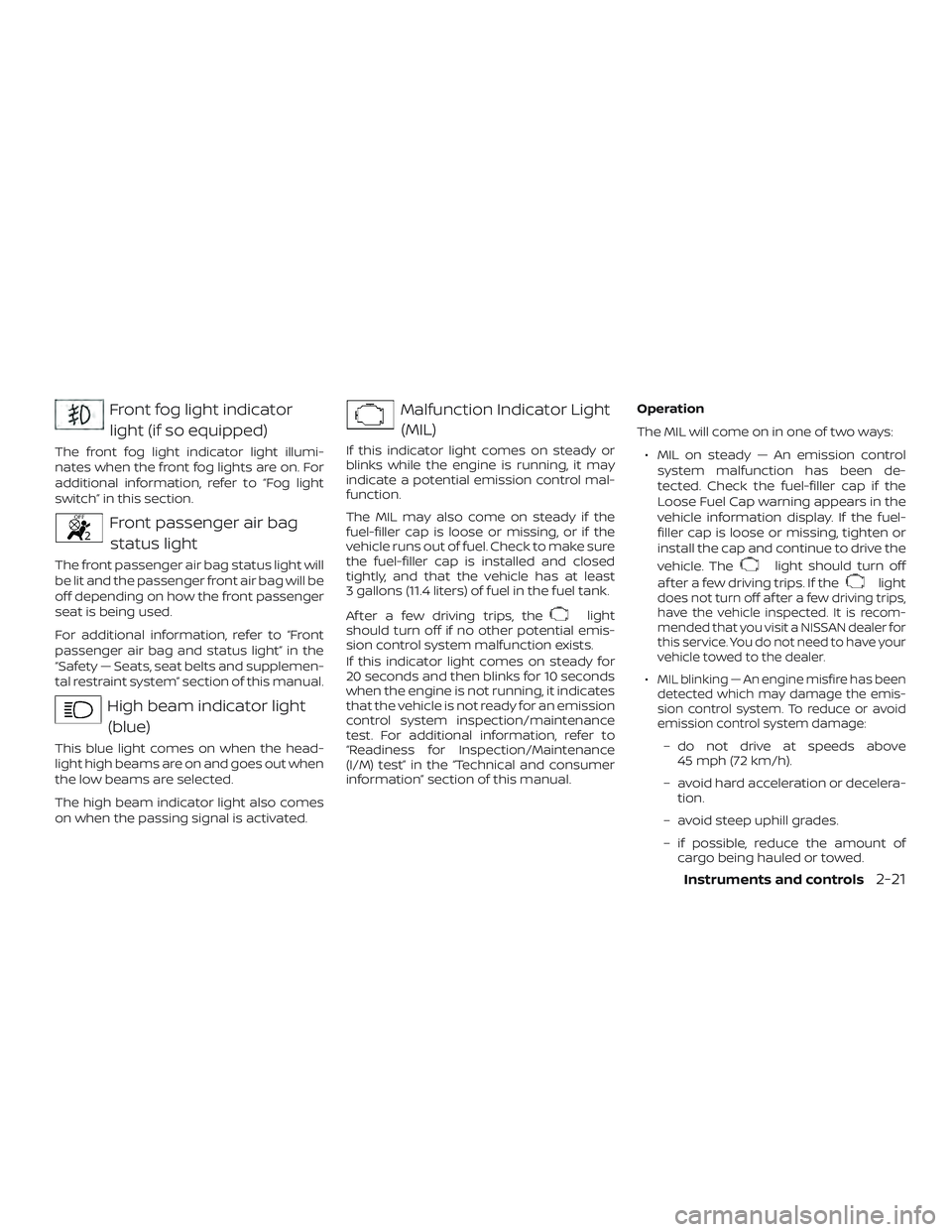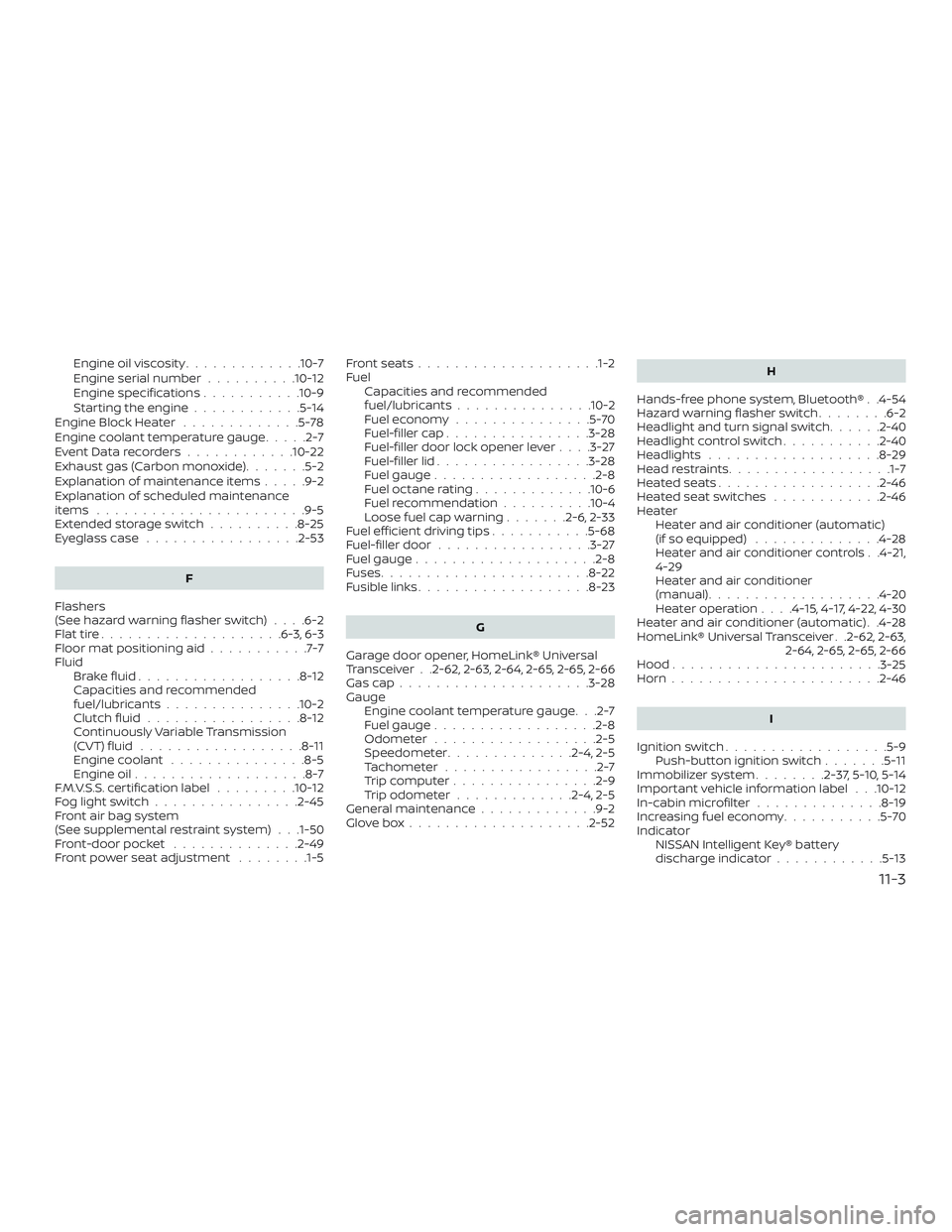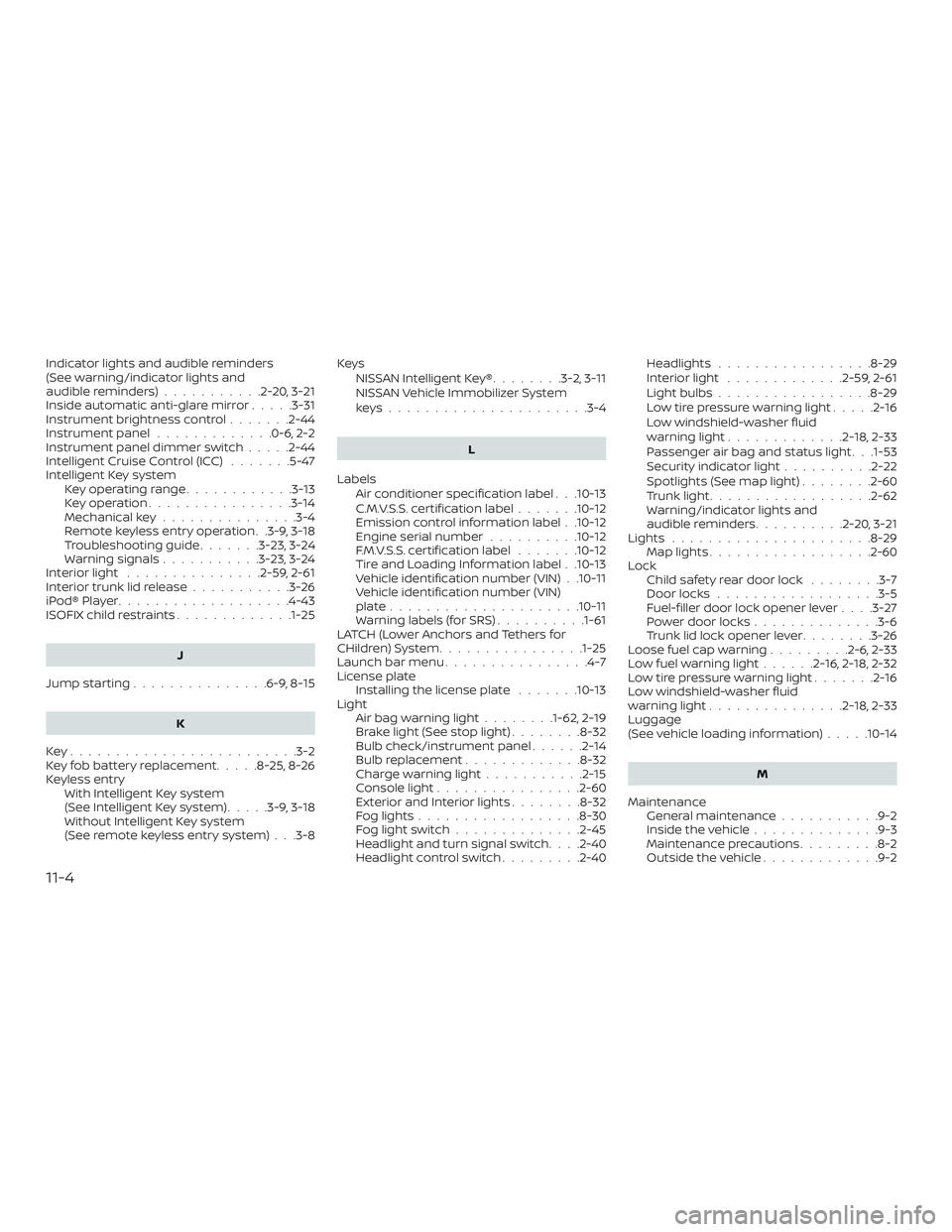2019 NISSAN SENTRA maintenance warning lights
[x] Cancel search: maintenance warning lightsPage 105 of 461

Front fog light indicatorlight (if so equipped)
The front fog light indicator light illumi-
nates when the front fog lights are on. For
additional information, refer to “Fog light
switch” in this section.
Front passenger air bagstatus light
The front passenger air bag status light will
be lit and the passenger front air bag will be
off depending on how the front passenger
seat is being used.
For additional information, refer to “Front
passenger air bag and status light” in the
“Safety — Seats, seat belts and supplemen-
tal restraint system” section of this manual.
High beam indicator light(blue)
This blue light comes on when the head-
light high beams are on and goes out when
the low beams are selected.
The high beam indicator light also comes
on when the passing signal is activated.
Malfunction Indicator Light(MIL)
If this indicator light comes on steady or
blinks while the engine is running, it may
indicate a potential emission control mal-
function.
The MIL may also come on steady if the
fuel-filler cap is loose or missing, or if the
vehicle runs out of fuel. Check to make sure
the fuel-filler cap is installed and closed
tightly, and that the vehicle has at least
3 gallons (11.4 liters) of fuel in the fuel tank.
Af ter a few driving trips, the
light
should turn off if no other potential emis-
sion control system malfunction exists.
If this indicator light comes on steady for
20 seconds and then blinks for 10 seconds
when the engine is not running, it indicates
that the vehicle is not ready for an emission
control system inspection/maintenance
test. For additional information, refer to
“Readiness for Inspection/Maintenance
(I/M) test” in the “Technical and consumer
information” section of this manual. Operation
The MIL will come on in one of two ways:
∙ MIL on steady — An emission control system malfunction has been de-
tected. Check the fuel-filler cap if the
Loose Fuel Cap warning appears in the
vehicle information display. If the fuel-
filler cap is loose or missing, tighten or
install the cap and continue to drive the
vehicle. The
light should turn off
af ter a few driving trips. If the
lightdoes not turn off af ter a few driving trips,
have the vehicle inspected. It is recom-
mended that you visit a NISSAN dealer for
this service. You do not need to have your
vehicle towed to the dealer.
∙MIL blinking — An engine misfire has been
detected which may damage the emis-
sion control system. To reduce or avoid
emission control system damage:
– do not drive at speeds above 45 mph (72 km/h).
– avoid hard acceleration or decelera- tion.
– avoid steep uphill grades.
– if possible, reduce the amount of cargo being hauled or towed.
Instruments and controls2-21
Page 414 of 461

ensure they operate smoothly and all
latches lock securely in every position.
Check that the head restraints/headrests
move up and down smoothly and the locks
(if so equipped) hold securely in all latched
positions.
Seat belts:Check that all parts of the seat
belt system (for example, buckles, anchors,
adjusters and retractors) operate properly
and smoothly, and are installed securely.
Check the belt webbing for cuts, fraying,
wear or damage.
Steering wheel: Check for changes in the
steering system, such as excessive free
play, hard steering or strange noises.
Warning lights and chimes: Make sure all
warning lights and chimes are operating
properly.
Windshield defroster: Check that the air
comes out of the defroster outlets properly
and in sufficient quantity when operating
the heater or air conditioner.
Windshield wiper and washer*: Check
that the wipers and washer operate prop-
erly and that the wipers do not streak.Under the hood and vehicle
The maintenance items listed here should
be checked periodically (for example, each
time you check the engine oil or refuel).
Battery* (for serviceable batteries):
Check the fluid level in each cell. The fluid
should be at the bottom of the filler open-
ing. Vehicles operated in high tempera-
tures or under severe conditions require
frequent checks of the battery fluid level.
NOTE:
Care should be taken to avoid situations
that can lead to potential battery dis-
charge and potential no-start conditions
such as:
1. Installation or extended use of elec-
tronic accessories that consume bat-
tery power when the engine is not
running (Phone chargers, GPS, DVD
players, etc.).
2. Vehicle is not driven regularly and/or
only driven short distances.
In these cases, the battery may need to
be charged to maintain battery health.
Brake and clutch (if so equipped) fluid
level*: Make sure that the brake and clutch fluid levels are between the MIN and MAX
lines on the reservoir.
Engine coolant level*:
Check the coolant
level when the engine is cold.
Engine drive belt*: Make sure the drive belt
is not frayed, worn, cracked or oily.
Engine oil level*: Check the level af ter
parking the vehicle on a level surface with
the engine off. Wait more than 15 minutes
for the oil to drain back into the oil pan.
Exhaust system: Make sure there are no
loose supports, cracks or holes. If the
sound of the exhaust seems unusual or
there is a smell of exhaust fumes, immedi-
ately have the exhaust system inspected. It
is recommended that you visit a NISSAN
dealer for this service. For additional infor-
mation, refer to “Exhaust gas (carbon mon-
oxide)” in the “Starting and driving” section
of this manual.
Fluid leaks: Check under the vehicle for
fuel, oil, water or other fluid leaks af ter the
vehicle has been parked for a while. Water
dripping from the air conditioner af ter use
is normal. If you should notice any leaks or if
fuel fumes are evident, check for the cause
and have it corrected immediately.
9-4Maintenance and schedules
Page 451 of 461

Engine oil viscosity.............10-7
Engine serial number ..........10-12
Engine specifications ...........10-9
Starting the engine ............5-14
Engine Block Heater .............5-78
Engine coolant temperature gauge .....2-7
EventDatarecorders............10-22
Exhaust gas (Carbon monoxide) .......5-2
Explanation of maintenance items .....9-2
Explanation of scheduled maintenance
items .......................9-5
Extended storage switch ..........8-25
Eyeglasscase .................2-53
F
Flashers
(See hazard warning flasher switch) ....6-2
Flattire....................6-3,6-3
Floormatpositioningaid...........7-7
Fluid Brakefluid..................8-12
Capacities and recommended
fuel/lubricants...............10-2
Clutchfluid.................8-12
Continuously Variable Transmission
(CVT) fluid ..................8-11
Engine coolant ...............8-5
Engine oil ...................8-7
F.M.V.S.S. certification label .........10-12
Foglightswitch................2-45
Front air bag system
(See supplemental restraint system) . . .1-50
Front-door pocket ..............2-49
Front power seat adjustment ........1-5Frontseats....................1-2
Fuel
Capacities and recommended
fuel/lubricants...............10-2
Fuel economy ...............5-70
Fuel-filler cap ................3-28
Fuel-filler door lock opener lever ....3-27
Fuel-filler lid .................3-28
Fuel gauge ..................2-8
Fueloctanerating.............10-6
Fuel recommendation ..........10-4
Loose fuel cap warning .......2-6,2-33
Fuel efficient driving tips ...........5-68
Fuel-filler door .................3-27
Fuel gauge ....................2-8
Fuses .......................8-22
Fusiblelinks...................8-23
G
Garage door opener, HomeLink® Universal
Transceiver . .2-62, 2-63, 2-64, 2-65, 2-65, 2-66
Gascap.....................3-28
Gauge Engine coolant temperature gauge. . .2-7
Fuel gauge ..................2-8
Odometer ..................2-5
Speedometer ..............2-4,2-5
Tachometer .................2-7
Trip computer ................2-9
Trip odometer .............2-4,2-5
General maintenance .............9-2
Glovebox....................2-52 H
Hands-free phone system, Bluetooth® . .4-54
Hazardwarningflasherswitch........6-2
Headlight and turn signal switch ......2-40
Headlightcontrolswitch...........2-40
Headlights ...................8-29
Headrestraints..................1-7
Heatedseats..................2-46
Heated seat switches ............2-46
Heater Heater and air conditioner (automatic)
(if so equipped) ..............4-28
Heater and air conditioner controls . .4-21,
4-29
Heater and air conditioner
(manual) ...................4-20
Heater operation ....4-15,4-17,4-22,4-30
Heater and air conditioner (automatic) . .4-28
HomeLink® Universal Transceiver . .2-62, 2-63, 2-64, 2-65, 2-65, 2-66
Hood .......................
3-25
Horn...................... .2-46
I
Ignition switch ..................5-9
Push-button ignition switch .......5-11
Immobilizer system ........2-37,5-10,5-14
Important vehicle information label . . .10-12
In-cabinmicrofilter ..............8-19
Increasing fuel economy ...........5-70
Indicator NISSAN Intelligent Key® battery
discharge indicator ............5-13
11-3
Page 452 of 461

Indicator lights and audible reminders
(See warning/indicator lights and
audible reminders)...........2-20,3-21
Inside automatic anti-glare mirror .....3-31
Instrument brightness control .......2-44
Instrument panel .............0-6,2-2
Instrument panel dimmer switch .....2-44
Intelligent Cruise Control (ICC) .......5-47
Intelligent Key system Key operating range ............3-13
Key operation ................3-14
Mechanical key ...............3-4
Remote keyless entry operation . .3-9, 3-18
Troubleshooting guide .......3-23,3-24
Warning signals ...........3-23,3-24
Interiorlight ...............2-59,2-61
Interiortrunklidrelease...........3-26
iPod®Player...................4-43
ISOFIX child restraints .............1-25
J
Jumpstarting...............6-9,8-15
K
Key.........................3-2
Key fob battery replacement .....8-25,8-26
Keyless entry With Intelligent Key system
(See Intelligent Key system) .....3-9,3-18
Without Intelligent Key system
(See remote keyless entry system) . . .3-8 Keys
NISSAN Intelligent Key® ........3-2,3-11
NISSAN Vehicle Immobilizer System
keys......................3-4
L
Labels Air conditioner specification label . . .10-13
C.M.V.S.S. certification label .......10-12
Emission control information label . .10-12
Engine serial number ..........10-12
F.M.V.S.S. certification label .......10-12
Tire and Loading Information label . .10-13
Vehicle identification number (VIN) . .10-11
Vehicle identification number (VIN)
plate.....................10-11
Warning labels (for SRS) ..........1-61
LATCH (Lower Anchors and Tethers for
CHildren)System................1-25
Launch bar menu ................4-7
License plate Installing the license plate .......10-13
Light Airbagwarninglight........1-62, 2-19
Brakelight(Seestoplight)........8-32
Bulb check/instrument panel ......2-14
Bulb replacement .............8-32
Charge warning light ...........2-15
Console light ................2-60
ExteriorandInteriorlights........8-32
Foglights..................8-30
Foglightswitch..............2-45
Headlight and turn signal switch ....2-40
Headlightcontrolswitch.........2-40 Headlights .................8-29
Interiorlight .............2-59,2-61
Lightbulbs.................8-29
Low tire pressure warning light
.....2-16
Low windshield-washer fluid
warninglight.............2-18,2-33
Passenger air bag and status light . . .1-53
Security indicator light ..........2-22
Spotlights(Seemaplight)........2-60
Trunklight..................2-62
Warning/indicator lights and
audible reminders ..........2-20,3-21
Lights......................8-29 Maplights..................2-60
Lock Child safety rear door lock ........3-7
Door locks ..................3-5
Fuel-filler door lock opener lever ....3-27
Power door locks ..............3-6
Trunk lid lock opener lever ........3-26
Loose fuel cap warning .........2-6,2-33
Lowfuelwarninglight......2-16, 2-18, 2-32
Low tire pressure warning light .......2-16
L
ow windshield-washer fluid
warninglight...............2-18,2-33
Luggage
(See vehicle loading information) .....10-14
M
Maintenance General maintenance ...........9-2
Insidethevehicle..............9-3
Maintenance precautions .........8-2
Outsidethevehicle.............9-2
11-4
Page 454 of 461

RecordersEventData.................10-22
Refrigerant recommendation ........10-8
Registering a vehicle in another
country .....................10-11
Remote keyless entry system ........3-8
Reporting safety defects (US only) . . . .10-20
S
Safety Child safety rear door lock ........3-7
Childseatbelts .....1-23, 1-29, 1-35, 1-40
Reporting safety defects (US only) . .10-20
Seat adjustment Front manual seat adjustment ......1-3
Front power seat adjustment ......1-5
Rear seat adjustment ...........1-6
Seatback pockets ...............2-50
Seat belt Childsafety................ .1-20
Infants and small children ........1-21
InjuredPerson............... .1-15
Largerchildren.............. .1-21
Precautions on seat belt usage .....1-12
Pregnant women ..............1-15
Seat belt extenders ............1-19
Seat belt maintenance ..........1-20
Seatbelts................1-12, 7-7
Shoulder belt height adjustment . . . .1-19
Three-pointtypewithretractor.....1-15
Seat belt extenders ..............1-19
Seatbeltwarninglight.........1-15, 2-19
Seats Adjustment ..................1-2 Armrests ...................1-7
Frontseats..................1-2
Heatedseats................2-46
Manual front seat adjustment
......1-3
Rearseat.................. .1-6
Security indicator light ............2-22
Security system
(NISSAN Vehicle Immobilizer System),
engine start.............2-37,5-10,5-14
Security systems Vehicle security system ......2-35,2-35
Self-adjustingbrakes.............8-21
Service manual order form .........10-22
Servicing air conditioner ...........4-31
Shif ting Continuously Variable Transmission
(CVT) .....................5-18
Manual transmission ...........5-23
Shiftlockrelease................5-21
Shoulder belt height adjustment ......1-19
Side air bag system (See supplemental
side air bag and curtain side-impact
airbagsystem)................ .1-58
Siri® Eyes-Free .................4-51
Spark plug replacement ...........8-17
Spark plugs ...................
8-17
Specifications ..................10-9
Speedometer ................2-4,2-5
SPORT mode switch .............5-26
Spotlights(Seemaplight)..........2-60
SRS warning label ...............1-61
Stability control .................5-74
Standard maintenance ............9-8
Starting Before starting the engine ........5-14
Jumpstarting.............6-9,8-15 Precautions when starting and
driving
.....................5-2
Push starting ................6-11
Starting the engine ............5-14
Starting the engine ..............5-14
Starting the engine (models with NISSAN
Intelligent Key® system) ...........5-16
Steering Power steering system ..........5-71
Steering wheel .................3-30
Steering wheel audio control switch . . .4-49
Stoplight....................8-32
Storage.....................2-49
Storagetray...................2-51
Sunglasses case ................2-53
Sunglasses holder ...............2-53
Sunroof ..................2-58, 2-58
Sunvisors....................3-30
Supplemental air bag warning labels . . .1-61
Supplemental air bag warning
light.................... .1-62, 2-19
Supplemental front impact air bag
system..................... .1-50
Supplemental restraint system Information and warning labels .....1-61
Precautions on supplemental
restraintsystem..............1-43
Supplemental restraint system
(Supplemental air bag system) .......1-43
Supplemental side and curtain
side-impact air bag system .........1-58
Switch Autolightswitch..............2-41
Automatic power window switch . . .2-56
Foglightswitch..............2-45
Hazard warning flasher switch ......6-2
11-6